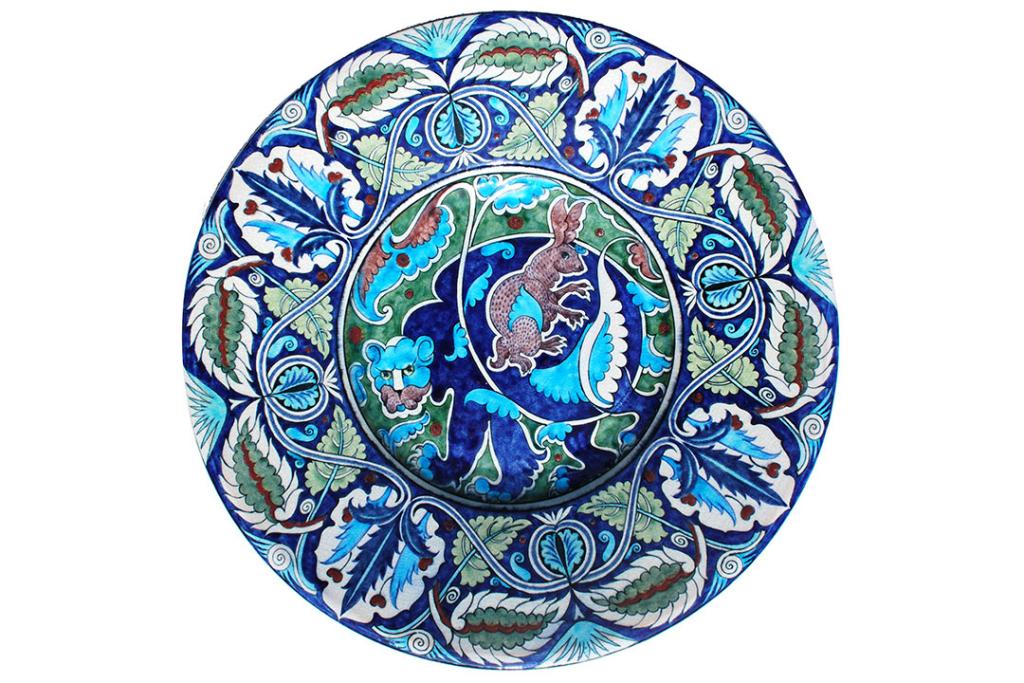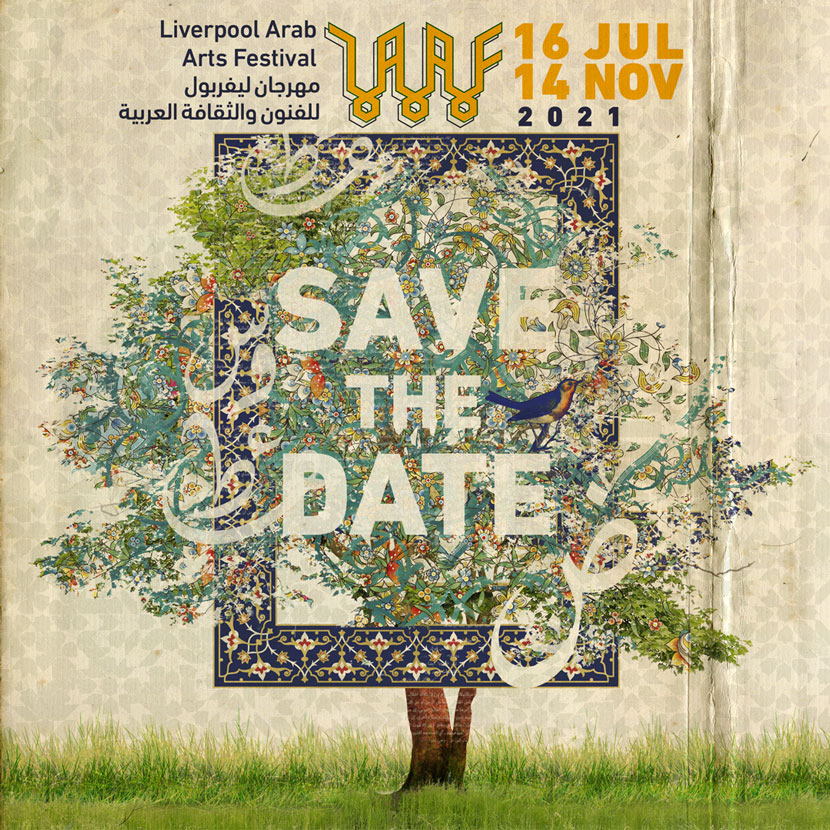Exploring Arabic design
William De Morgan was influenced by Arab design in the patterns and techniques used for his ceramics. Laura Marie Brown takes a look at the origins of this traditional Arabic aesthetic and its enduring influence.

At Liverpool Arab Arts Festival we have a foot in two worlds, the Arab and the Liverpool, and design can articulate that in such a powerful way. Arab graphic design has the capacity to tell a story, visually, in an arresting manner.
We are always looking for inspiration and can often find it in unusual places. A good starting point is often history and tracing back where trends and ideas emerged. Late in 2020, a book was published by American University in Cairo Press exploring ‘A History of Arab Graphic Design’. Written by Bahia Sheheab and Haytham Nawar, the text explores the emergence of Arab graphic design in the early 20th century. It was a period when so many economic, social and political changes were taking place in the Arab world and graphic design sought to emulate and give expression to those changes.
The work contained in this book features key Arab designers who were working during De Morgan’s lifetime. If they were partly his inspiration, what was theirs?

Creating for the collective knowledge
The development of an Arab graphic design aesthetic and visual culture is rooted in Islamic art and Arabic calligraphy and how they, in turn, impact Arab visual culture. The evolution of graphic design over the past century has given a perceptible, modern reframing of the traditional art and craft work seen across the Arab world while placing it into the hands of today’s artists and consumers.
It is important when we say Middle Eastern and talk of ‘The Arab World’ we are talking about 420 million people. The Arab League is 22 nations. We cannot point to a single influence or a single trend that encapsulates the work of every artist and designer that identifies as Arab.
Yet the desire to reflect, to construct a narrative that roots modern graphic design in tradition seems to nod to a re-evaluation at the heart of modern Arab culture. How can we take this style, that has existed for centuries, and ensure it speaks to our generation, to our definition of Arab-ness, while still adhering to its custom and culture? As Bahia Shehab says, when talking about why they started the book with Islamic art, it was because “in Islamic art, you don’t create for yourself, you create for the collective knowledge”.
The desire to use a visual identity to represent one’s culture is not unique to the Arab world, but there is certainly a movement and a growing commitment to keep traditional crafts and styles alive, particularly within graphic design.
Typography and geometry
The Khatt Foundation established the Centre for Arabic Typography in Amsterdam in 2004. It is a cultural foundation and a design research centre, mission to advance design and typography in the Middle East, North Africa and their diaspora.
Arabic typography is particularly interesting within Arab graphic design. There is a film by Jan de Bruin which explores ‘Typographic matchmaking in the Maghreb’ where there is a tri-script font family; Arabic, Tiginagh and Latin. Those scripts each have to work together harmoniously, and this film explores how they do this, on the streets, in galleries, exhibitions, on the exterior and interior of buildings and in books.
Typographic Matchmaking in the Maghrib from Jan de Bruin on Vimeo.
The evolution of this typography is like a guide through how culture has evolved. These scripts have co-existed for centuries, representing different cultures. Script, language and how it appears can be used to chart how a place and its people have changed, how they have moved together, co-aligned their lives and people.
This is right at the heart of Arabic visual identity. The three cornerstones; calligraphy, arabesque and geometry - are so tied to belief, to culture, to faith, history and mysticism it is a conscious choice to use it and adopt it. The exploration of it, the growth in the study of it at cultural venues like the Khatt Foundation, are to get to the heart of Arab identity and culture.
Why is this so important in Arab culture? It goes back to the Qur’an. An excellent essay here explains the geometry of Sufi calligraphy and its relationship to mysticism. It is a practice that recognises the written word can reveal truth. Qur’anic calligraphy is a holy art, a work where every Arabic letter relates to a circle and its diameter, where the primordial dot, which you see in Arabic script, is a symbol of deity. It is a mathematically based decoration, developing a divine and mystical purpose in linguistics, that unites geometry and calligraphy to aid in the understanding of God’s message.
In Islamic culture, figurative images cannot become objects of worship, so instead, aesthetically, this decorative, mathematically-based aesthetic and design pattern becomes a way of representing faith, message bringing the corporeal into the spiritual realm.
Maths was also an important factor in De Morgan’s designs, as you will no doubt have noticed if you visited the Sublime Symmetry exhibition. The Bear and Hare plate in particular (pictured above) illustrates his use of complex geometric patterns with intertwining arabesque motifs.
Contemporary design
Current Arab graphic design blends contemporary style with a more traditional aestheic, using geometric structures and other cultural marking points. For modern graphic designers, all of this information blends into a cultural melting pot, reflecting, in some ways, the rich diversity within the Arab world.

For the Liverpool Arab Arts Festival in 2021 we worked with Arab designer Rami Kanso, who lives between Beirut and London, to create our visual identity, creating our branding as a piece of art in itself.
You can see all three features of traditional Arabic design in his commission for this year’s festival, despite the fact the artwork he has created is contemporary in its feel. The geometric pattern in the background, the arabesque influence in the frame - which also appears in our social media design, the calligraphy layered through the imagery.
This ability to take traditional practice, to mould it and shape it is part of a perennial desire within younger Arab generations to make their own mark on historic culture and heritage.
Delve deeper into this culture each year with the Liverpool Arab Arts Festival.
Lead image: Large Wide Rimmed Bear and Hare Dish © De Morgan Foundation
